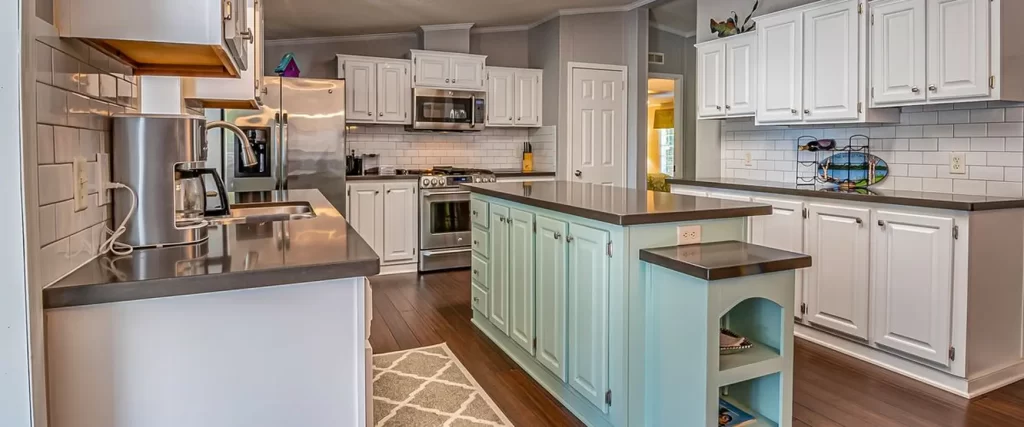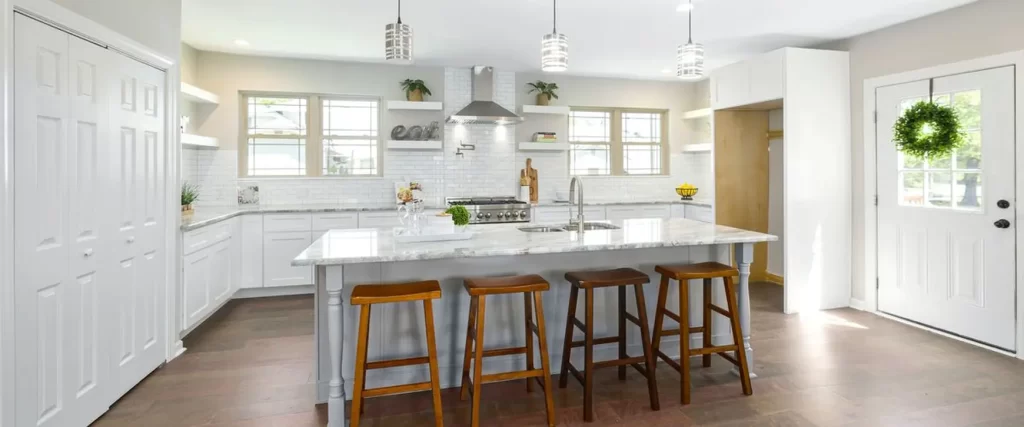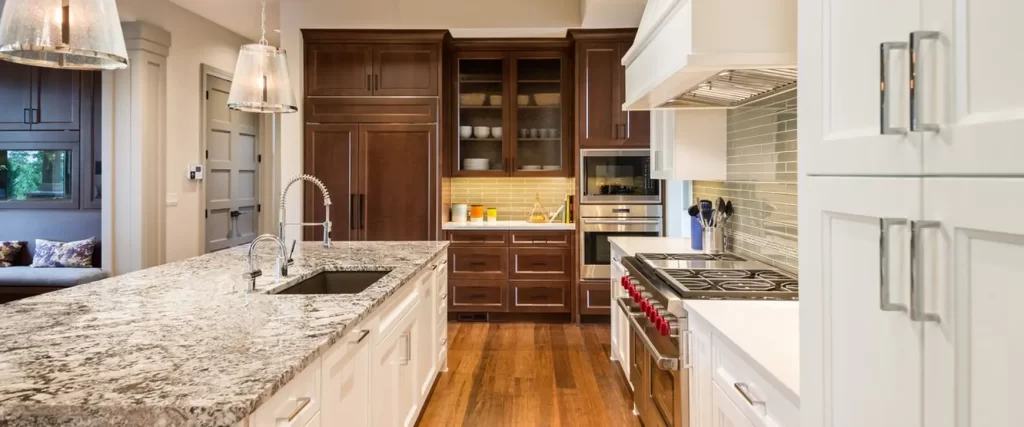If you live in a Colonial-style home near Morganville Elementary or anywhere nearby, you know there’s something special about these homes. The charm, the symmetry, the timeless curb appeal. But when it comes to the kitchen, many Colonial homes fall short of today’s expectations. Tight layouts, dated cabinetry, and limited storage are common headaches.
So, what do you do when your beautiful Colonial needs a modern, functional kitchen, without losing its historical character? That’s exactly what we’re diving into today.
This post is packed with practical design tips tailored for Colonial kitchens, with a focus on homes just like yours. Whether you’re getting serious about remodeling or still dreaming things up, you’ll walk away with insights that make your next step much clearer.

Why Colonial Kitchens Are Unique and Why That Matters
Colonial-style homes in areas like Morganville typically feature:
- Symmetrical layouts with central hallways
- Formal dining and living rooms
- Modest-sized kitchens, often closed off from other spaces
- Traditional architectural details like wainscoting, molding, and brick or wood floors
Because of this, kitchen renovations in these homes can’t be approached like you would in a modern ranch or open-concept new build. You need a smart balance of preservation and modernization.
In regions like Central New Jersey, homes built in the 1940s through 1980s tend to have some original layouts still intact, and that includes walls that separate the kitchen from the dining area or family room. This gives you a few options depending on how traditional or modern you want to go.
Design Tips for Renovating a Colonial Kitchen
Open It Up (But Thoughtfully)
While open-concept kitchens are incredibly popular, you don’t need to knock down every wall. Instead, consider:
- Removing just one wall to create a kitchen-dining pass-through or half-open space
- Widening a doorway or arch for better flow without sacrificing charm
- Using glass cabinet doors or open shelving to visually expand the room
This keeps the original Colonial feel intact but brings in the light and movement of modern layouts.
Embrace the Original Footprint, Upgrade the Flow
If knocking down walls isn’t an option (or just not your style), focus on reconfiguring within the existing layout:
- Reposition appliances for better workflow (think fridge, sink, stove triangle)
- Add a small island or peninsula for extra prep and seating space
- Replace oversized furniture with built-ins or space-saving solutions
It’s all about working with the space, not against it.
Honor the Colonial Style in Your Materials
You don’t have to go full farmhouse, but Colonial kitchens really shine when you use materials and colors that nod to their roots:
- Painted wood cabinetry in warm whites, slate blues, or soft grays
- Shaker-style or raised-panel doors
- Soapstone or honed granite countertops
- Subway tile or brick backsplashes
- Wide-plank or natural wood floors
All of these elements play well with both classic and updated aesthetics.
Upgrade Lighting (It Changes Everything)
Many Colonial kitchens weren’t built with lighting in mind. Make yours shine by:
- Adding recessed lighting for general brightness
- Installing pendant lights over islands or sinks
- Using under-cabinet lighting to reduce shadows and highlight counters
Lighting alone can make a kitchen feel twice as big.
Maximize Storage in Creative Ways
Colonials often lack built-in storage, so clever solutions are key:
- Add tall pantry cabinets or a built-in hutch
- Use drawers instead of lower cabinets—they’re more accessible
- Include hidden storage in islands or banquettes
Good storage keeps your kitchen clean, functional, and enjoyable to use every day.

Best Cabinet & Fixture Manufacturers for Colonial-Style Kitchens
Choosing the right cabinetry, fixtures, and surfaces will make a big difference in both the look and feel of your space. Here are some top-rated manufacturers trusted for Colonial kitchen renovations:
- KraftMaid: Classic wood cabinets with tons of customizable options to match Colonial-style homes.
- Wellborn Cabinet: American-made and known for traditional craftsmanship and timeless finishes.
- Cambria Quartz: Durable countertops with subtle, elegant veining are perfect for period homes with a modern edge.
- Blanco: High-quality sinks and faucets that blend modern function with traditional aesthetics.
- Emtek Hardware: Stylish cabinet knobs and pulls with vintage finishes and authentic Colonial vibes.
Our Team Brings Years of Colonial Kitchen Renovation Expertise
We’ve been helping homeowners just like you remodel kitchens in Colonial-style homes for years. We understand the structural quirks, the historical details, and the balance between keeping character and creating functionality.
As with anything in life, working with experts makes all the difference. It’s not just about getting the job done; it’s about getting it done right. That saves you money, stress, and time down the road.
If you’re ready to tackle your Colonial kitchen renovation with a team that actually knows what they’re doing, contact us at (732) 788-4737. Let’s bring your vision to life.

Frequently Asked Questions About Colonial Kitchen Renovations
Is it possible to have an open-concept kitchen in a Colonial home?
Yes, with proper structural planning. Removing or modifying walls is common, but it’s important to maintain balance with the rest of the house’s layout.
How much does a Colonial kitchen remodel usually cost?
Costs vary based on size, materials, and scope. Most homeowners in this region spend anywhere from $30,000 to $90,000.
Will I need permits to remodel my kitchen?
Yes, depending on what changes you’re making. Electrical, plumbing, and structural changes usually require permits. We’ll help guide you through that process.
How long does a full kitchen renovation take?
A complete remodel typically takes 6–12 weeks, depending on design complexity, material availability, and any structural work involved.
Can I keep my old cabinets and just repaint them?
Sometimes, yes. If the cabinet boxes are in good shape, refinishing or refacing is a cost-effective option, especially in vintage homes.
Is it better to replace the floor or refinish it?
In many Colonial homes, hardwood floors can be refinished beautifully. But if they’re too damaged or you want a new layout, replacement might make more sense.
What’s the best countertop material for a Colonial-style kitchen?
Honed granite, soapstone, or matte quartz. These offer both durability and a classic look that fits the style.
Should I add an island to my Colonial kitchen?
If space allows, yes. A small island can improve function and add storage, but it has to fit the flow of the room.
Final Thoughts: Make the Most of Your Colonial Kitchen
A Colonial kitchen renovation isn’t just about upgrading a room; it’s about upgrading your entire experience at home. When you design with care and intention, the result is a space that feels authentic and modern.
Whether you’re ready to open up the layout, add more storage, or just finally replace those 1970s cabinets, the key is working with a team that understands Colonial-style homes inside and out.
Let’s talk about your kitchen remodeling goals and how we can bring them to life. Contact us at (732) 788-4737 and we’ll walk you through your options, timeline, and everything you need to feel confident in your decision.
